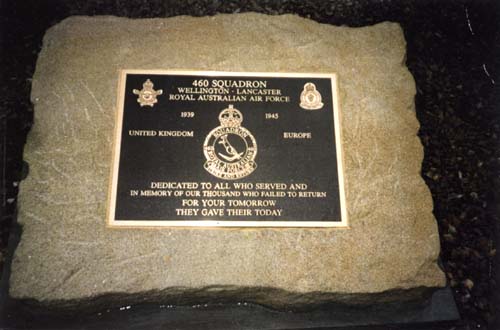 Commemorative Stone and Plaque in the "Airmen's Garden of Remembrance" RAAF Station Amberley, Queensland, Australia.
Commemorative Stone and Plaque in the "Airmen's Garden of Remembrance" RAAF Station Amberley, Queensland, Australia.
Reproduced from the Official Squadron Histories
- 1940 Jun 4 – Hitler proclaims a war of total annihilation against his enemies
- 1940 Aug 4 – Commence bombing of London
- 1940 Sep 7 – Buckingham Palace hit by delayed action bomb
- 1940 Sep 11 – Fire bombs dropped in and around Buckingham Palace
- 1940 Nov 11 – Coventry heavily bombed cathedral destroyed
- 1940 Dec 22 – London severely bombed and burned by incendiaries. The Guildhall and eight Wrenn churches destroyed
- 1941 Feb 27 – Cardiff heavily attacked with fire bombs
- 1941 May 8 – Heavy attacks on London; Westminster Abbey, Houses of Parliament, and the British Museum damaged
The British night bomber offensive against Germany had been directed since early 1942 by Air Chief Marshal Sir Arthur Harris, who said, "A lot of people say that bombing can never win the war". His answer to that was "Well, it has never been tried yet and we shall see". And later he stated, "I would not regard any cities of Germany as worth the bones of one of our airmen".
The Royal Air Force Bomber Command, following the Battle of Britain, was the means to carry the war to Germany. The aircrews knew the odds weighed heavily against their own survival when carrying out air attacks on the industries of Germany. Flying a bomber, over Germany, with flak and fighters, and risk of collision, was one of the most demanding, and deadly experiences in World War Two.
A tour of operations was 30 trips, the life expectancy of a crew was 6 trips, and of the Lancaster 10 trips. The chance of completing the 30 trips was only 44%. Because of the heavy casualties on 460 squadron, there was not any one plane, which flew 100 operations.
Royal visits and heroic accolades were heaped upon the men of Bomber Command which lost 56,000 men killed in WWII.
In the first few weeks after D–Day the RAF was losing more men than the British 2nd Army in Normandy, and aircrew were amongst the most highly skilled manpower.
By early 1945 the cities of Germany were battered on an unprecedented scale. Dr. Goebbels wrote: "The situation grows daily more intolerable, we have no means of defending ourselves against the catastrophe".
Reports tell of so much sorrow and misery one hardly dares to think about them in detail. 600,000 Germans died. It is difficult to decide which is the more terrifying experience; to bomb or to be bombed.
If any airman, due to a breakdown in nerves, sickness, fright, or any other reason, was unable to, or refused to fly, he was branded LMF (lack of moral fibre). Aircrew were not very happy about this label. Someone could fly twenty trips and due to nerves, stretched beyond the limit of endurance, then be branded LMF. Unlike the brand of cowardice, which carried the death penalty in the First World War, LMF meant stripping of wings, (a qualification badge) stripping of rank, and a dishonourable discharge.
Once they flew over enemy occupied territory, waiting for the airmen was a Nazi defence force of 900,000 members. Some 900 night fighters 6,880 searchlights, and slightly in excess 20,600 anti aircraft (ack–ack) guns.
In the first three months of 1944, Bomber Command lost 80% of the aircraft and crews that had been on active squadrons at the end of 1943.
Approximately 9,000 members of the RAAF served in Bomber Command. They were about 2% of all Australian enlistments for all services. Yet they accounted for 20% of all Australian combat deaths during the war.
| European theatre (Germany and Italy) | 6,666 |
| Bomber command | 3,486 |
| (1018 on 460 Squadron) | |
| Coastal command | 408 |
| Fighter command | 171 |
| Middle East | 1,135 |
| Training exercises | 724 |
| India/Burma | 242 |
| South–West Pacific | 3,342 |
| Other Areas | 163 |
| In the Korean fighting | 41 |
| And in the Vietnam fighting | 74 |
Author's note: "there were 110,000 aircrew who flew on operations in Bomber Command and 51% (55,564) were killed, many of them with no known graves.
The US 8th Air Force lost 26,000 killed"
 Commemorative Stone and Plaque in the "Airmen's Garden of Remembrance" RAAF Station Amberley, Queensland, Australia.
Commemorative Stone and Plaque in the "Airmen's Garden of Remembrance" RAAF Station Amberley, Queensland, Australia.